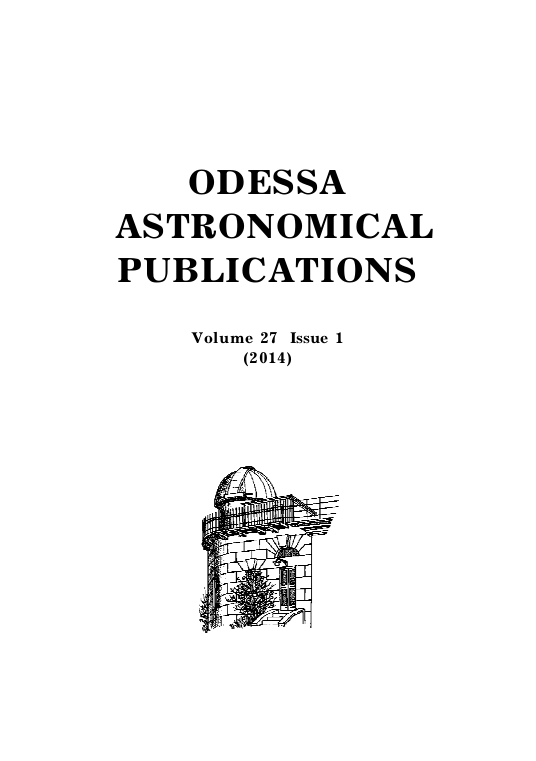REVERBERATION MEASUREMENT OF THE INNER RADIUS OF THE DUST TORUS IN NGC 4151 DURING 2008-2013
DOI:
https://doi.org/10.18524/1810-4215.2014.27.80952Ключові слова:
AGN, optical and IR variability, time delay, data analysis, dust torus, cosmologyАнотація
We investigate the correlation between infrared (JHKL) and optical (B) fluxes of the variable nucleus of the Seyfert galaxy NGC 4151 using partially published data for the last 6 years (2008-2013). Here we are using the same data as in Oknyansky et al. (2014), but include also optical (B) data from Guo et al. We find that the lag of flux in all the infrared bands is the same, 40 ± 6 days, to within the measurement accuracy. Variability in the J and K bands is not quite simultaneous, perhaps due to the differing contributions of the accretion disk in these bands. The lag found for the K band compared with the B band is not significantly different from earlier values obtained for the period 2000-2007. However, finding approximately the same lags in all IR bands for 2008-2013 differs from previous results at earlier epochs when the lag increased with increasing wavelength. Examples of almost the same lag in different IR bands are known for some other active nuclei. In the case of NGC 4151 it appears that the relative lags between the IR bands may be different in different years. The available data, unfortunately, do not allow us to investigate a possible change in the lags during the test interval. We discuss our results in the framework of the standard model where the variable infrared radiation is mainly due to thermal reemission from the part of the dusty torus closest to the central source. There is also a contribution of some IR emission from the accretion disk, and this contribution increases with decreasing wavelength. Some cosmological applications of obtained results are discussed.
Посилання
Barvainis, R.: 1987, Ap. J. 320,537.
Barvainis, R.:1992 Ap. J. 400, 502.
Guo D.F. et al.: 2014, Res. in A&A., 14, 923.
Gaskell, C. M; Sparke, L. S.:1986, Ap. J. 305, 175.
Hönig S.F. ; Kishimoto M. 2011: A&A,. 524, A121.
Hönig S.F.: 2014, Ap. J.Lett., 774, L4.
Kobayashi Y. et. al.:1998, Proc. SPIE, 3352, 120.
Oknyansky V.L. et al.: 2014, Astron. Lett.,40, 527.
Oknyanskij V.L. et al.: 2008, OAP, 21, 79.
Oknyanskij, V. L.; Horne, K.:2001, ASP Conf. Proc. 224, 149.
Oknyanskij V.L. et.al.:2006, ASP Conf. Ser. 360, 75.
Oknyanskij, V.L:1993 Astron. Lett. 19, 416.
Oknyanskij V.L. et.al.:1999, Astron. Lett. 25, 483.
Oknyanskij V.L.:2002, ASP Conf. Proc., 282, 330.
Roberts C.A., Rumstey, K. R.:2012 J. South. Associat. Res. Astron. 6, 47.
Schnülle A. et al.: 2013, A&A, 557, L13.
Yoshii Y. et al.:2014, Ap.J.Lett., 784, L11.
##submission.downloads##
Опубліковано
Як цитувати
Номер
Розділ
Ліцензія
Авторське право (c) 2016 Odessa Astronomical Publications

Ця робота ліцензується відповідно до Creative Commons Attribution-NonCommercial 4.0 International License.
Відповідно Закону України про авторське право і суміжні права N 3792-XII від 23 грудня 1993 року
